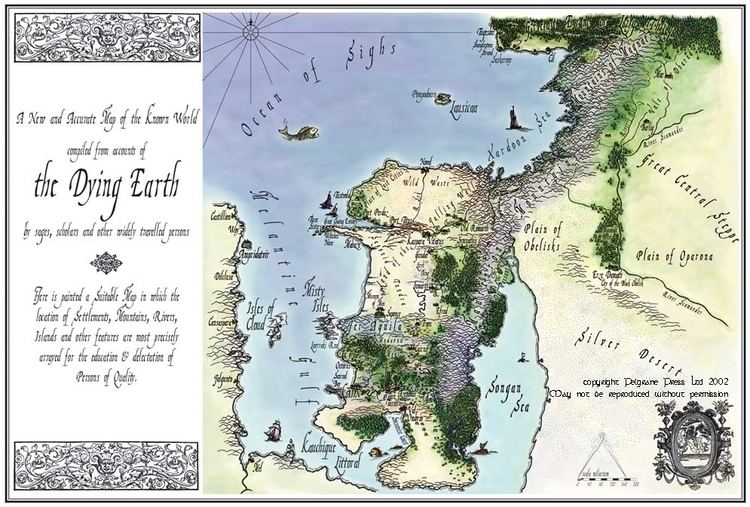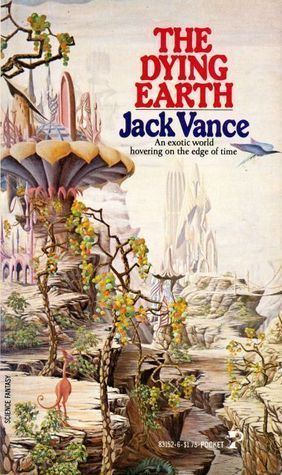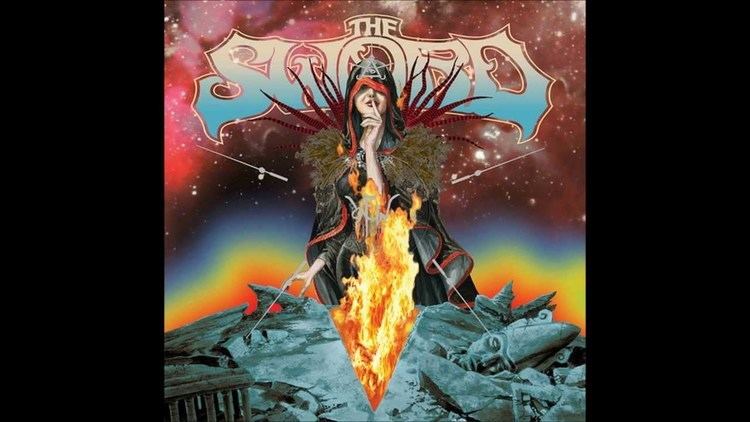Language English Media type Print Number of books 4 Genres Fantasy, Dying Earth | Published 1950–1984 Country United States of America | |
 | ||
Cover artist variousGerald Brom, depicted No. of books 4 by Vance (see sequels) Characters Guyal, Ulan Dhor, Turjan, T'sais, Mazirian, Liane Books The Dying Earth, The Eyes of the Overworld, Cugel's Saga, Rhialto the Marvellous, Songs of the Dying Earth | ||
The dying earth
Dying Earth is a fantasy series by the American author Jack Vance, comprising four books originally published from 1950 to 1984. Some have been called picaresque. They vary from short story collection to fix-up (novel created from older short stories) perhaps all the way to novel.
Contents
- The dying earth
- Talking about jack vance s the dying earth lots of spoilers
- Setting
- Origins
- Series
- Stories by Vance
- Sequels
- Translations
- Legacy
- Role playing
- References
The first book in the series, The Dying Earth, was ranked number 16 of 33 "All Time Best Fantasy Novels" by Locus in 1987, based on a poll of subscribers, although it was marketed as a collection and the ISFDB calls it a "loosely connected series of stories".

Talking about jack vance s the dying earth lots of spoilers
Setting

The stories of the Dying Earth series are set in the distant future, at a point when the sun is almost exhausted and magic has reasserted itself as a dominant force. The Moon has disappeared and the Sun is in danger of burning out at any time, often flickering as if about to go out, before shining again. The various civilizations of Earth have collapsed for the most part into decadence and its inhabitants overcome with a fatalistic outlook. The Earth is mostly barren and cold, and has become infested with various predatory monsters (possibly created by a magician in a former age).
Origins

Vance wrote the stories of the first book while he served in the United States Merchant Marine during World War II. In the late 1940s several of his other stories were published in magazines.

According to pulp editor Sam Merwin, Vance's earliest magazine submissions in the 1940s were heavily influenced by the style of James Branch Cabell. Fantasy historian Lin Carter has noted several probable lasting influences of Cabell on Vance's work, and suggests that the early "pseudo-Cabell" experiments bore fruit in The Dying Earth (1950).
Series

The series comprises four books by Vance and some sequels by other authors that may be or may have been canonical.

One 741-page omnibus has been issued as The Compleat Dying Earth (SF Book Club, 1999) and in both the US and UK as Tales of the Dying Earth (2000).
Stories by Vance
All four books were published with Tables of Contents, the first and fourth as collections. The second and third contained mostly material previously published in short story form but were marketed as novels, the second as a fix-up and the third without acknowledging any previous publication.
1. The Dying Earth (the author's preferred title is Mazirian the Magician) was openly a collection of six stories, all original, although written during Vance's WWII service. ISFDB calls them "slightly connected" and catalogs the last as a novella (17,500 to 40,000 word count).
2. Eyes of the Overworld (the author's preferred title is Cugel the Clever) was a fix-up of six stories, presented as seven. All were novelettes by word count (7500 to 17,500). Five were previously published as noted here.
3. Cugel's Saga (the author's preferred title is Cugel: The Skybreak Spatterlight) was marketed as a novel. ISFDB calls it "[t]wice as large and less episodic than Eyes of the Overworld" but qualifies that label. "This is marketed as a novel, but there is a table of contents, and some of the parts were previously published (although none are acknowledged thus)." It catalogs previous publication of three chapters without remark on the degree of revision.
4. Rhialto the Marvellous was marketed as a collection, a Foreword and three stories, one previously published. The Foreword is non-narrative canonical fiction presenting the general state of the world in the 21st Aeon (a "short story" loosely).
Sequels
Some sequels have been written by other authors, either with Vance's authorization or as tributes to his work.
Michael Shea's first publication, the novel A Quest for Simbilis (DAW Books, 1974, OCLC 2128177), was an authorized sequel to Eyes. However, "When Vance returned to the milieu, his Cugel's Saga continued the events of The Eyes of the Overworld in a different direction."
The tribute anthology Songs of the Dying Earth (2009) contains short fiction set in the world of the Dying Earth by numerous writers alongside tributes to Vance's work and influence.
In 2010 Shea wrote another authorized story belonging to the Dying Earth series and featuring Cugel as one of characters: "Hew the Tintmaster", published in the anthology Swords & Dark Magic: The New Sword and Sorcery, ed. Jonathan Strahan and Lou Anders (Eos, 2010, pp. 323–362).
Translations
WorldCat contributing libraries report holding all four books in French, Spanish, and (in omnibus edition) Hebrew translations; and report holding The Dying Earth in five other languages: Finnish, German, Japanese, Polish, and Russian.
The whole first volume (six stories) has been translated also into Esperanto together with two Cugel stories and made available on-line as e-books by a long-time fan and Vance Integral Edition co-worker. Permission to translate and distribute (only into Esperanto) was obtained informally direct from the author and, since his death in 2013, continues with ongoing permission from the author's estate. To date these are three: Mazirian the Magician, The Sorcerer Pharesm, and The Bagful of Dreams available for free download as EPub, Mobi and PDF.
Legacy
The Dying Earth subgenre of science fiction is named in recognition of Vance's role in standardizing a setting, the entropically dying earth and sun. Its importance was recognized with the publication of Songs of the Dying Earth, a tribute anthology edited by George R. R. Martin and Gardner Dozois (Subterranean, 2009). Each short story in the anthology is set on the Dying Earth, and concludes with a short acknowledgement by the author of Vance's influence on them.
Some particular works since Vance should be singled out.
Gene Wolfe's The Book of the New Sun (1980–83) is set in a slightly similar world, and was written under Vance's influence. Wolfe suggested in The Castle of the Otter, a collection of essays, that he inserted the book The Dying Earth into his fictional world under the title The Book of Gold (specifically, Wolfe wrote that the "Book of Gold" mentioned in The Book of the New Sun is different for each reader, but for him it was "The Dying Earth.")'. Wolfe has extended the series.
Michael Shea's novel Nifft the Lean (1982), his second book eight years after A Quest for Simbilis, also owes much debt to Vance's creation, since the protagonist of the story is a petty thief (not unlike Cugel the Clever), who travels and struggles in an exotic world. Shea returned to Nifft with 1997 and 2000 sequels.
The Archonate stories by Matthew Hughes — the 1994 novel Fools Errant and numerous works in this millennium — take place in "the penultimate age of Old Earth," a period of science and technology that is on the verge of transforming into the magical era of the time of the Dying Earth. Booklist has called him Vance's "heir apparent." (Review by Carl Hays of The Gist Hunter and Other Stories, Booklist, August 2005)
Role-playing
The original creators of the Dungeons & Dragons games were fans of Jack Vance and incorporated many aspects of the Dying Earth series into the game. The magic system, in which a wizard is limited in the number of spells that can be simultaneously remembered and forgets them once they are cast, was based on the magic of Dying Earth. In role-playing game circles, this sort of magic system is called 'Vancian'. Some of the spells from Dungeons & Dragons are based on spells mentioned in the Dying Earth series, such as the prismatic spray. Magic items from the Dying Earth stories such as ioun stones also made their way into Dungeons & Dragons. One of the deities of magic in Dungeons & Dragons is named Vecna (an anagram of Vance).
The Talislanta role-playing game designed by Stephan Michael Sechi and originally published in 1987 by Bard Games was inspired by the works of Jack Vance so much so that the first release, The Chronicles of Talislanta is dedicated to the author.
There is an official Dying Earth role-playing game published by Pelgrane Press with an occasional magazine The Excellent Prismatic Spray (named after a magic spell). The game situates players in Vance's world populated by desperately extravagant people. Many other role-playing settings pay homage to the series by including fantasy elements he invented such as the darkness-dwelling Grues.
